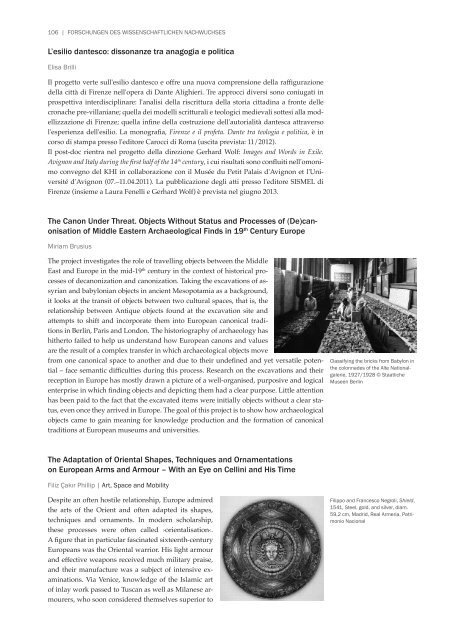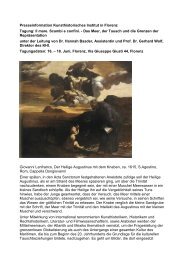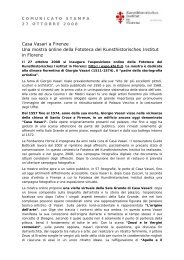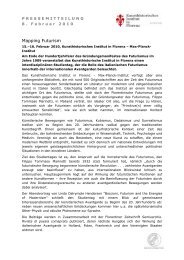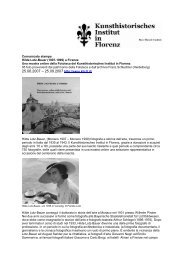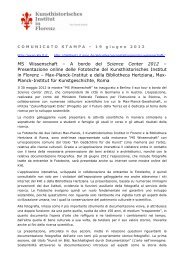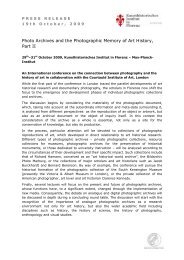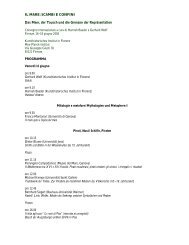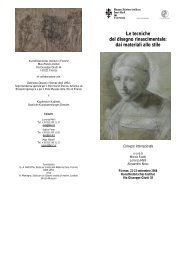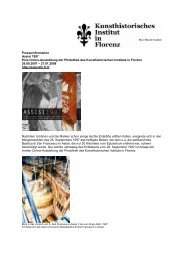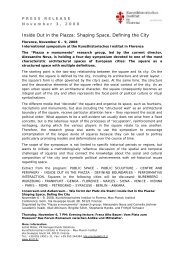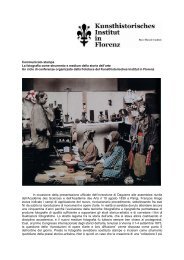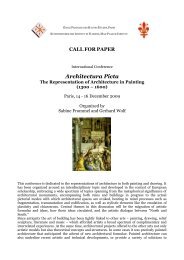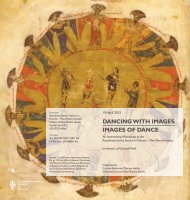forschungsbericht november 2008 – juli 2012 - Kunsthistorisches ...
forschungsbericht november 2008 – juli 2012 - Kunsthistorisches ...
forschungsbericht november 2008 – juli 2012 - Kunsthistorisches ...
Erfolgreiche ePaper selbst erstellen
Machen Sie aus Ihren PDF Publikationen ein blätterbares Flipbook mit unserer einzigartigen Google optimierten e-Paper Software.
106 | FORSCHUNGEN DES WISSENSCHAFTLICHEN NACHWUCHSES<br />
L’esilio dantesco: dissonanze tra anagogia e politica<br />
Elisa Brilli<br />
Il progetto verte sull'esilio dantesco e offre una nuova comprensione della raffigurazione<br />
della città di Firenze nell'opera di Dante Alighieri. Tre approcci diversi sono coniugati in<br />
prospettiva interdisciplinare: l'analisi della riscrittura della storia cittadina a fronte delle<br />
cronache pre-villaniane; quella dei modelli scritturali e teologici medievali sottesi alla modellizzazione<br />
di Firenze; quella infine della costruzione dell'autorialità dantesca attraverso<br />
l'esperienza dell'esilio. La monografia, Firenze e il profeta. Dante tra teologia e politica, è in<br />
corso di stampa presso l'editore Carocci di Roma (uscita prevista: 11/<strong>2012</strong>).<br />
Il post-doc rientra nel progetto della direzione Gerhard Wolf: Images and Words in Exile.<br />
Avignon and Italy during the first half of the 14 th century, i cui risultati sono confluiti nell'omonimo<br />
convegno del KHI in collaborazione con il Musée du Petit Palais d'Avignon et l'Université<br />
d'Avignon (07.<strong>–</strong>11.04.2011). La pubblicazione degli atti presso l'editore SISMEL di<br />
Firenze (insieme a Laura Fenelli e Gerhard Wolf) è prevista nel giugno 2013.<br />
The Canon Under Threat. Objects Without Status and Processes of (De)canonisation<br />
of Middle Eastern Archaeological Finds in 19 th Century Europe<br />
Miriam Brusius<br />
The project investigates the role of travelling objects between the Middle<br />
East and Europe in the mid-19 th century in the context of historical processes<br />
of decanonization and canonization. Taking the excavations of assyrian<br />
and babylonian objects in ancient Mesopotamia as a background,<br />
it looks at the transit of objects between two cultural spaces, that is, the<br />
relationship between Antique objects found at the excavation site and<br />
attempts to shift and incorporate them into European canonical traditions<br />
in Berlin, Paris and London. The historiography of archaeology has<br />
hitherto failed to help us understand how European canons and values<br />
are the result of a complex transfer in which archaeological objects move<br />
from one canonical space to another and due to their undefined and yet versatile potential<br />
<strong>–</strong> face semantic difficulties during this process. Research on the excavations and their<br />
reception in Europe has mostly drawn a picture of a well-organised, purposive and logical<br />
enterprise in which finding objects and depicting them had a clear purpose. Little attention<br />
has been paid to the fact that the excavated items were initially objects without a clear status,<br />
even once they arrived in Europe. The goal of this project is to show how archaeological<br />
objects came to gain meaning for knowledge production and the formation of canonical<br />
traditions at European museums and universities.<br />
Classifying the bricks from Babylon in<br />
the colonnades of the Alte Nationalgalerie,<br />
1927/1928 © Staatliche<br />
Museen Berlin<br />
The Adaptation of Oriental Shapes, Techniques and Ornamentations<br />
on European Arms and Armour <strong>–</strong> With an Eye on Cellini and His Time<br />
Filiz Çakır Phillip | Art, Space and Mobility<br />
Despite an often hostile relationship, Europe admired<br />
the arts of the Orient and often adapted its shapes,<br />
techniques and ornaments. In modern scholarship,<br />
these processes were often called ›orientalisation‹.<br />
A figure that in particular fascinated sixteenth-century<br />
Europeans was the Oriental warrior. His light armour<br />
and effective weapons received much military praise,<br />
and their manufacture was a subject of intensive examinations.<br />
Via Venice, knowledge of the Islamic art<br />
of inlay work passed to Tuscan as well as Milanese armourers,<br />
who soon considered themselves superior to<br />
Filippo and Francesco Negroli, Shield,<br />
1541, Steel, gold, and silver, diam.<br />
59,2 cm, Madrid, Real Armeria, Patrimonio<br />
Nacional


